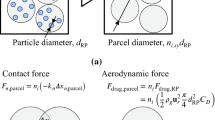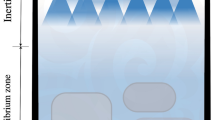Abstract
A two-dimensional numerical simulation of the interaction between a shock wave and a particle cloud curtain (PCC) in a shock tube was conducted to develop the numerical method and to understand how the particle layer mitigates the shock wave. In the present study, computational fluid dynamics/the discrete element method in conjunction with drag force and convective heat transfer models were used to separately solve the continuum fluid and particle dynamics. The applicability of the method to the gas flow and particles was validated through comparison with gas–particle shock-tube experiments, in which the PCC was generated by free fall, and particles initially had a gradient of its volume fraction and falling velocity in height. When the incident shock wave interacted with the PCC, it was reflected from and transmitted through the PCC. The transmitted shock wave had a curved front because the initial gradient in the volume fraction of particles locally changed the interaction between the shock wave and the particles. We calculated the effects of the drag force and heat transfer in mitigating the strength of the transmitted shock wave. The propagation of the transmitted and reflected shock waves and the motion of the PCC induced by the gas flow behind the shock wave agreed well with previous experimental data. After the interaction between the gas flow and the PCC, drag force and heat transfer were activated by the gradients in pressure, velocity, and temperature between them, and the gas flow lost momentum and energy, which weakened the transmitted shock wave. At the same time, the PCC gained momentum and energy and was dispersed. The contact forces between two particles affected the local dispersion of the PCC.









Similar content being viewed by others
References
Homae, T., Wakabayashi, K., Matsumura, T., Nakayama, Y.: Attenuation of blast wave using sand around a spherical pentolite. Sci. Technol. Energy Mater. 68, 90–93 (2007)
Rigby, S.E., Fay, S.D., Clarke, S.D., Tyas, A., Reay, J.J., Warren, J.A., Gant, M., Elgy, I.: Measuring spatial pressure distribution from explosives buried in dry Leighton Buzzard sand. Int. J. Impact Eng. 96, 89–104 (2016). https://doi.org/10.1016/j.ijimpeng.2016.05.004
Sugiyama, Y., Izumo, M., Ando, H., Matsuo, A.: Two-dimensional explosion experiments examining the interaction between a blast wave and a sand hill. Shock Waves 28, 627–630 (2018). https://doi.org/10.1007/s00193-018-0813-5
Pontalier, Q., Loiseau, J., Goroshin, S., Frost, D.L.: Experimental investigation of blast mitigation and particle-blast interaction during the explosive dispersal of particles and liquids. Shock Waves 28, 489–511 (2018). https://doi.org/10.1007/s00193-018-0821-5
Annamalai, S., Rollin, B., Ouellet, F., Neal, C., Jackson, T.L., Balachander, S.: Effects of initial perturbations in the early moments of an explosive dispersal of particles. J. Fluid Eng. 138, 070903 (2016). https://doi.org/10.1115/1.4030954
Dahal, J., McFarland, J.A.: A numerical method for shock driven multiphase flow with evaporating particles. J. Comput. Phys. 344, 210–233 (2017). https://doi.org/10.1016/j.jcp.2017.04.074
Paudel, M., Dahal, J., McFarland, J.: Particle evaporation and hydrodynamics in a shock driven multiphase instability. Int. J. Multiph. Flow 101, 137–151 (2018). https://doi.org/10.1016/j.ijmultiphaseflow.2018.01.008
Sugiyama, Y., Homae, T., Wakabayashi, K., Matsumura, T., Nakayama, Y.: Numerical simulations on the attenuation effect of a barrier material on a blast wave. J. Loss Prev. Process Ind. 32, 135–143 (2014). https://doi.org/10.1016/j.jlp.2014.08.007
Pontalier, Q., Loiseau, J., Milne, A.M., Longbottom, A.W., Frost, D.L.: Numerical investigation of particle–blast interaction during explosive dispersal of liquids and granular materials. Shock Waves 28, 513–531 (2018). https://doi.org/10.1007/s00193-018-0820-6
Houim, R.W., Oran, E.S.: A multiphase model for compressible granular-gaseous flows: formulation and initial tests. J. Fluid Mech. 789, 166–220 (2016). https://doi.org/10.1017/jfm.2015.728
Lucy, L.B.: A numerical approach to the testing of the fission hypothesis. Astron. J. 82, 1013–1024 (1977). https://doi.org/10.1086/112164
Tsuji, Y., Kawaguchi, T., Tanaka, T.: Discrete particle simulation of two-dimensional fluidized bed. Powder Technol. 77, 79–87 (1993). https://doi.org/10.1016/0032-5910(93)85010-7
Andrews, M.J., O’Rourke, P.J.: The multiphase particle-in-cell (MP-PIC) method for dense particulate flows. Int. J. Multiph. Flow 22, 379–402 (1996). https://doi.org/10.1016/0301-9322(95)00072-0
Akiki, G., Jackson, T.L., Balachandar, S.: Pairwise interaction extended point-particle model for a random array of monodisperse shperes. J. Fluid Mech. 813, 882–928 (2017). https://doi.org/10.1017/jfm.2016.877
van der Hoef, M.A., van Sint Annaland, M., Deen, N.G., Kuipers, J.A.M.: Numerical simulation of dense gas-solid fluidized beds: A multiscale modeling strategy. Annu. Rev. Fluid Mech. 40, 47–70 (2008). https://doi.org/10.1146/annurev.fluid.40.111406.102130
Ben-Dor, G., Britan, A., Elperin, T., Igra, O., Jiang, J.P.: Experimental investigation of the interaction between weak shock waves and granular layers. Exp. Fluids 22, 432–443 (1997). https://doi.org/10.1007/s003480050069
Ling, Y., Wagner, J.L., Beresh, S.J., Kearney, S.P., Balachandar, S.: Interaction of a planar shock wave with a dense particle curtain: Modeling and experiments. Phys. Fluids 24, 113301 (2012). https://doi.org/10.1063/1.4768815
Lv, H., Wang, Z., Li, J.: Experimental study of planar shock wave interactions with dense packed sand wall. Int. J. Multiph. Flow 89, 255–265 (2017). https://doi.org/10.1016/j.ijmultiphaseflow.2016.07.019
Theofanous, T.G., Mitkin, V., Chang, C.-H.: The dynamics of dense particle clouds subjected to shock waves. Part 1. Experiments and scaling laws. J. Fluid Mech. 792, 658–681 (2016). https://doi.org/10.1017/jfm.2016.97
Wagner, J.L., Beresh, S.J., Kearney, S.P., Trott, W.M., Castaneda, J.N., Pruett, B.O., Bear, M.R.: A multiphase shock tube for shock wave interactions with dense particle fields. Exp. Fluids 52, 1507–1517 (2012). https://doi.org/10.1007/s00348-012-1272-x
Bordoloi, A.D., Martinez, A.A., Prestridge, K.: Relaxation drag history of shock accelerated microparticles. J. Fluid Mech. 823, R4 (2017). https://doi.org/10.1017/jfm.2017.389
Rogue, X., Rodriguez, G., Haas, J.F., Saurel, R.: Experimental and numerical investigation of the shock-induced fluidization of a particles bed. Shock Waves 8, 29–45 (1998). https://doi.org/10.1007/s001930050096
Khmel, T.A., Fedorov, A.V.: Effect of collision dynamics of particles on the processes of shock wave dispersion. Combust. Explos. Shock Waves 52, 207–218 (2016). https://doi.org/10.1134/S0010508216020118
Shimura, K., Matsuo, A.: Two-dimensional CFD–DEM simulation of vertical shock wave-induced dust lifting processes. Shock Waves 28, 1285–1297 (2018). https://doi.org/10.1007/s00193-018-0848-7
Middlebrooks, J.B., Avgoustopoulos, C.G., Black, W.J., Allen, R.C., McFarland, J.A.: Droplet and multiphase effects in a shock-driven hydrodynamic instability with reshock. Exp. Fluids 59, 98 (2018). https://doi.org/10.1007/s00348-018-2547-7
Vorobieff, P., Anderson, M., Conroy, J., White, R., Truman, C.R., Kumar, S.: Vortex formation in a shock-accelerated gas induced by particle seeding. Phys. Rev. Lett. 106, 184503 (2011). https://doi.org/10.1103/PhysRevLett.106.184503
Ishii, M., Hibiki, T.: Thermo-Fluid Dynamics of Two-Phase Flow. Springer, New York (2011). https://doi.org/10.1007/978-1-4419-7985-8
McBride, B., Gordon, S., Reno, M.A.: Coefficient for calculating thermodynamic and transport properties of individual species. NASA Tech. Memo. 4513, 10–73 (1993)
Gidaspow, D.: Multiphase Flow and Fluidization: Continuum and Kinetic Theory Descriptions. Academic Press, Boston (1994)
Gordon, S., McBride, B., Zeleznik, F.J.: Computer program for calculation of complex chemical equilibrium compositions and applications. Experiment 1: Transport Properties. NASA Technical Memorandum 86885 (1984)
Gunn, D.J.: Transfer of heat and mass to particles in fixed and fluidized beds. Int. J. Heat Mass Trans. 21, 467–476 (1978). https://doi.org/10.1016/0017-9310(78)90080-7
Black, W.J., Denissen, N., McFarland, J.A.: Particle force model effects in a shock-driven multiphase instability. Shock Waves 28, 463–472 (2018). https://doi.org/10.1007/s00193-017-0790-0
Theofanous, T.G., Chang, C.-H.: The dynamics of dense particle clouds subjected to shock waves. Part 2. Modeling/numerical issues and the way forward. Int. J. Multiph. Flows 89, 177–206 (2017). https://doi.org/10.1016/j.ijmultiphaseflow.2016.10.004
Sakai, M., Abe, M., Shigeto, Y., Mizutani, S., Takahashi, H., Vire, A., Percival, J., Xiang, J., Pain, C.: Verification and validation of coarse grain model of the DEM in a bubbling fluidized bed. Chem. Eng. J. 244, 33–43 (2014). https://doi.org/10.1016/j.cej.2014.01.029
Kitamura, K., Shima, E.: Towards shock-stable and accurate hypersonic heating computations: A new pressure flux for AUSM-family schemes. J. Comput. Phys. 245, 62–83 (2013). https://doi.org/10.1016/j.jcp.2013.02.046
Gottlieb, S., Shu, C., Tadmor, E.: Strong stability-preserving high-order time discretization methods. SIAM Rev. 43, 89–112 (2001). https://doi.org/10.1137/S003614450036757X
Boiko, V.M., Kiselev, V.P., Kiselev, S.P., Papyrin, A.N., Poplavsky, S.V., Fomin, V.M.: Shock wave interaction with a cloud of particles. Shock Waves 7, 275–285 (1997). https://doi.org/10.1007/s001930050082
DeMauro, E.P., Wagner, J.L., Beresh, S.J., Farias, P.A.: Unsteady drag following shock wave impingement on a dense particle curtain measured using pulse-burst PIV. Phys. Rev. Fluids 2, 064301 (2017). https://doi.org/10.1103/PhysRevFluids.2.064301
Author information
Authors and Affiliations
Corresponding author
Additional information
Communicated by D. Frost and A. Higgins.
Publisher's Note
Springer Nature remains neutral with regard to jurisdictional claims in published maps and institutional affiliations.
Rights and permissions
About this article
Cite this article
Sugiyama, Y., Ando, H., Shimura, K. et al. Numerical investigation of the interaction between a shock wave and a particle cloud curtain using a CFD–DEM model. Shock Waves 29, 499–510 (2019). https://doi.org/10.1007/s00193-018-0878-1
Received:
Revised:
Accepted:
Published:
Issue Date:
DOI: https://doi.org/10.1007/s00193-018-0878-1




